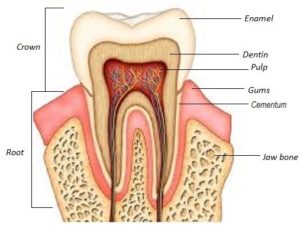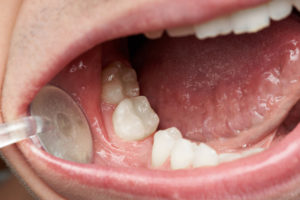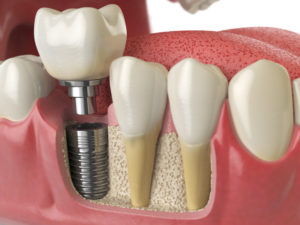How to Prevent Bone Loss after Tooth Extraction
One of the consequences of losing a tooth that most people are unaware of is also losing the bone surrounding that tooth. It is something that few consider when having a tooth removed. When a tooth is missing, the jawbone that used to surround it begins to shrink. First, it shrinks in width, and then it begins to shorten in height. This article will help you understand why it happens, why it matters, and what you can do about it.
What Causes Bone Loss after Tooth Extraction?
 The bone surrounding the teeth, called alveolar bone, serves one purpose only: to hold and support teeth. You have probably heard of bone loss in association with gum disease (periodontal disease). That occurs when bacterial toxins in plaque buildup destroy the bone around a tooth when the tooth is still in place. After an extraction, the bone simply recedes because it no longer has a tooth to surround.
The bone surrounding the teeth, called alveolar bone, serves one purpose only: to hold and support teeth. You have probably heard of bone loss in association with gum disease (periodontal disease). That occurs when bacterial toxins in plaque buildup destroy the bone around a tooth when the tooth is still in place. After an extraction, the bone simply recedes because it no longer has a tooth to surround.
It is the loss of chewing forces on that area of bone that leads to the bone loss. When a tooth makes contact with an opposing tooth during biting or chewing, the force is transmitted down the roots and into the surrounding bone. This stimulates tiny bone-making cells to go to work. Without chewing force, those cells don’t function, and the bone slowly withers away.
Why does Bone Loss after Tooth Extraction Matter?
There are a few risks associated with losing bone in the area of a missing tooth. The risks increase when there are multiple missing teeth in a row.
-
It causes gum and bone recession on neighboring teeth.
The teeth on either side of a missing tooth will generally suffer from recession of both the gums and bone on the side of the tooth facing the empty space. Over time, this loss of support compromises the overall health of these neighboring teeth.
-
It weakens the bone and results in a higher risk of jaw fractures.
When multiple teeth are missing in a row, the jawbone becomes thin in width and short in height. Basically, it becomes a lot weaker. If you were to sustain a fall or injury to the face, that weakened area of jawbone is much more likely to break.
-
It could prevent future restoration of that missing tooth with a dental implant.
 Many people have a tooth extraction out of necessity and even urgency sometimes. This means they may not plan to immediately replace the tooth with a dental implant, pushing it out into the distant future. It is possible for the bone in the missing tooth’s area to shrink so much that there is no longer enough bone to support a dental implant.
Many people have a tooth extraction out of necessity and even urgency sometimes. This means they may not plan to immediately replace the tooth with a dental implant, pushing it out into the distant future. It is possible for the bone in the missing tooth’s area to shrink so much that there is no longer enough bone to support a dental implant.
In the majority of cases, your surgeon can augment the area of bone with a type of bone grafting surgery, which may provide enough width and height of bone for an implant. Of course, as with most things, it is far simpler and less expensive to prevent the loss of bone rather than attempt to rebuild it.
How Can you Slow Down Bone Loss after Tooth Extraction?
When your dentist extracts a tooth, if you know that you want to replace it with an implant at some point in the future, she will discuss the option of a “socket preservation graft”. This is a very simple type of bone graft in which material is placed directly into the extraction site as soon as the tooth comes out. By filling in the extraction socket and providing a scaffolding on which new bone can grow, you can slow down the process of bone loss.
We say “slow down” instead of “prevent” in this case because you could still continue to lose bone over time.
How Do you Prevent Bone Loss after Tooth Extraction?
 To actually prevent the bone loss from occurring after a tooth extraction, you must replace the missing tooth as soon as possible. To be more specific, you must replace the missing tooth’s root as soon as possible, and the way to do that is with a dental implant.
To actually prevent the bone loss from occurring after a tooth extraction, you must replace the missing tooth as soon as possible. To be more specific, you must replace the missing tooth’s root as soon as possible, and the way to do that is with a dental implant.
There is absolutely nothing wrong with choosing a different tooth replacement option, like a bridge or removable partial. They simply do not replace the root of the tooth, so they do not prevent bone loss over time. This is particularly noticeable to patients with removable appliances like partials and dentures. They can easily detect the changes over time as the bone shrinks, and a small space develops between the denture and the gums. This leads to sore spots, rubbing, looseness, and difficulty chewing.
To prevent this, a dental implant is the answer. The implant is the only tooth replacement options that anchors into the bone itself and gives the bone a renewed function in holding the implant.
More Questions about Tooth Loss, Bone Loss or Missing Tooth Replacement Options?
Call Designer Smiles today to schedule a consultation with Dr. Ann and Dr. Lauren. They can answer all of your questions, assess your current situation, and help you decide on the best path forward.
